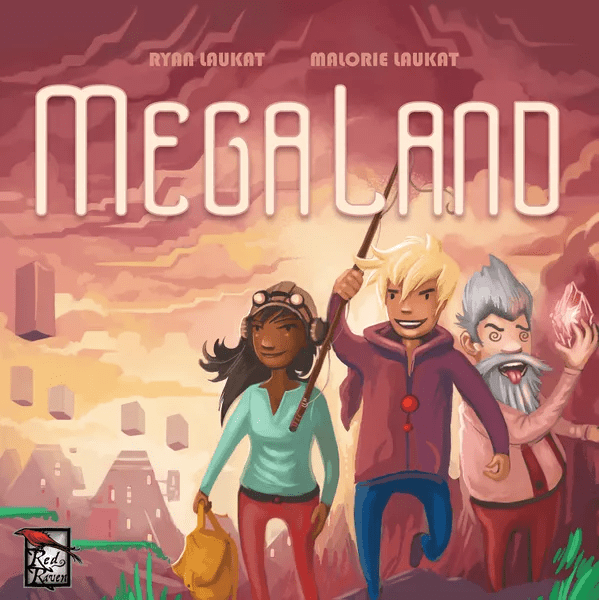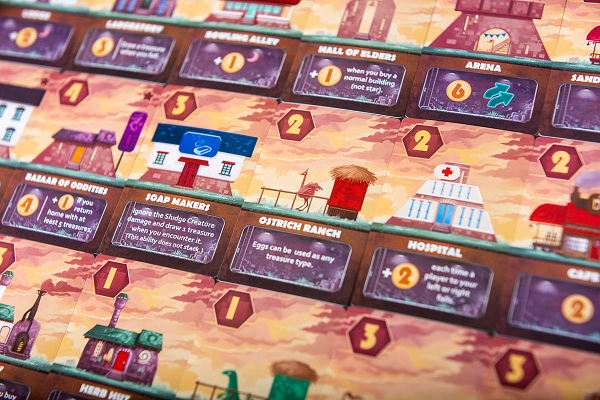Decide How Far You Will Venture for Treasure in Megaland

Venture through the levels, collecting treasure. But be careful not to go too far, or else you’ll be knocked out and forced to return to town empty-handed.
Published by Red Raven Games, Megaland is a 20-minute push-your-luck game, designed for 2-5 players.
Gameplay
Each player takes a character and four heart tokens. The same six basic building types are used each time you play the game, and players also choose seven other building types to add to the building display. You then shuffle the level cards and the game begins.
The game is played over three phases. During phase one, each player decides if they will enter the next level. Each player who chooses to do so draws a treasure card. Treasure cards can be one of six different types. After each player has made their choice, you draw the next level card. Players lose one heart for each injury shown on the card. If a player ever runs out of hearts, he is automatically returned to town and loses all the treasure he gathered that round. After resolving any injuries, players must again decide whether to move on to the next level or return to town. When you choose to return to town, you get to keep all the treasure you collected that round. One level card is the treasure box, which allows each player who stayed to draw an extra treasure. There are also jump tokens that you can acquire sometimes during the game. Before revealing the next level card, you can choose to spend a jump token. This allows you to ignore any injuries on the next level card if it has a jump symbol. Not all injuries can be jumped over, however, and even if the jump token had no effect, it is still discarded.
Once all players have returned to town, either by choice or by running out of health, you move on to the second phase. The second phase is the buy phase. During this phase, players take turns buying buildings. Each building lists how many unique treasure cards it costs to purchase. You cannot buy the same building twice in the same round. Some buildings will give you coins upfront when you purchase them, while others will give you coins at the end of each round. Yet others will give you special abilities, such as allowing you to draw a new treasure card and discard one each time you return to town. You can also purchase extra hearts by paying matching treasure cards; the more hearts you already have, the more expensive a new one will be.
Finally, you move on to the night phase. During this phase, some buildings activate their abilities, such as the lodge that gives you two coins every night phase. You must then store or discard any treasures remaining in your supply. Each building you own can hold one treasure card. Any treasure you cannot store is discarded. Each player then regains any hearts they lost during the round, and the level deck is reshuffled. If no one has 20 coins, you play a new round. If at least one player has reached 20 coins, the player with the most coins wins the game.

Review
Megaland feels like a cross between Incan Gold and Machi Koro. The push-your-luck aspect is well done, with enough innocuous level cards that it’s easy to build up a satisfying streak, but enough heavy hitters that, especially early on when you have fewer hearts, it’s easy get knocked out fast and unexpectedly. The luck element of the game can also be felt in elements such as which treasure cards you draw. You might walk away with six treasures, but depending on how many matches you have, this might not be as great a turn as you’d expect since you need unique ones to buy buildings.
Meanwhile, the prices for buildings are nice and clear, and there’s a nice range of rewards and abilities across the buildings. Additionally, even if due to bad luck you can only afford the cheapest buildings, the fact that each building can store one treasure is quite helpful and allows you to save up for the more expensive buildings in turn.
There’s a nice range of building cards included in the game, meaning that trying out different combos will increase the game’s replayability and change your strategies. For example, the first time we played, we didn’t actually have any buildings that provided jump icons. This also means you can adjust the complexity of the buildings you play with based on the group playing.
The theme feels a bit tacked on, with the rulebook giving a video game setting and using some video game language, but nothing in the mechanics or the aesthetics really back it up. That being said, the game does look really nice, and the components are quite well-made. The artwork gives the game a sense of having its own unique world, and the box insert is also very well-thought-out and makes the game both easy to pack and unpack.
We quite enjoyed Megaland. The choices aren’t complex, but they’re interesting. It’s definitely a game you could play as a family or with an adult game group. Adding players will not add too much downtime, and there’s not really any direct player interaction, but games are pretty quick. It’s a nice combination of mechanics that still doesn’t feel overly complicated. The final result is a nice, casual, family-friendly board game.
Pros: Great artwork, easy to learn, quick gameplay
Cons: Theme is a little weakly implemented, not any real player interaction







